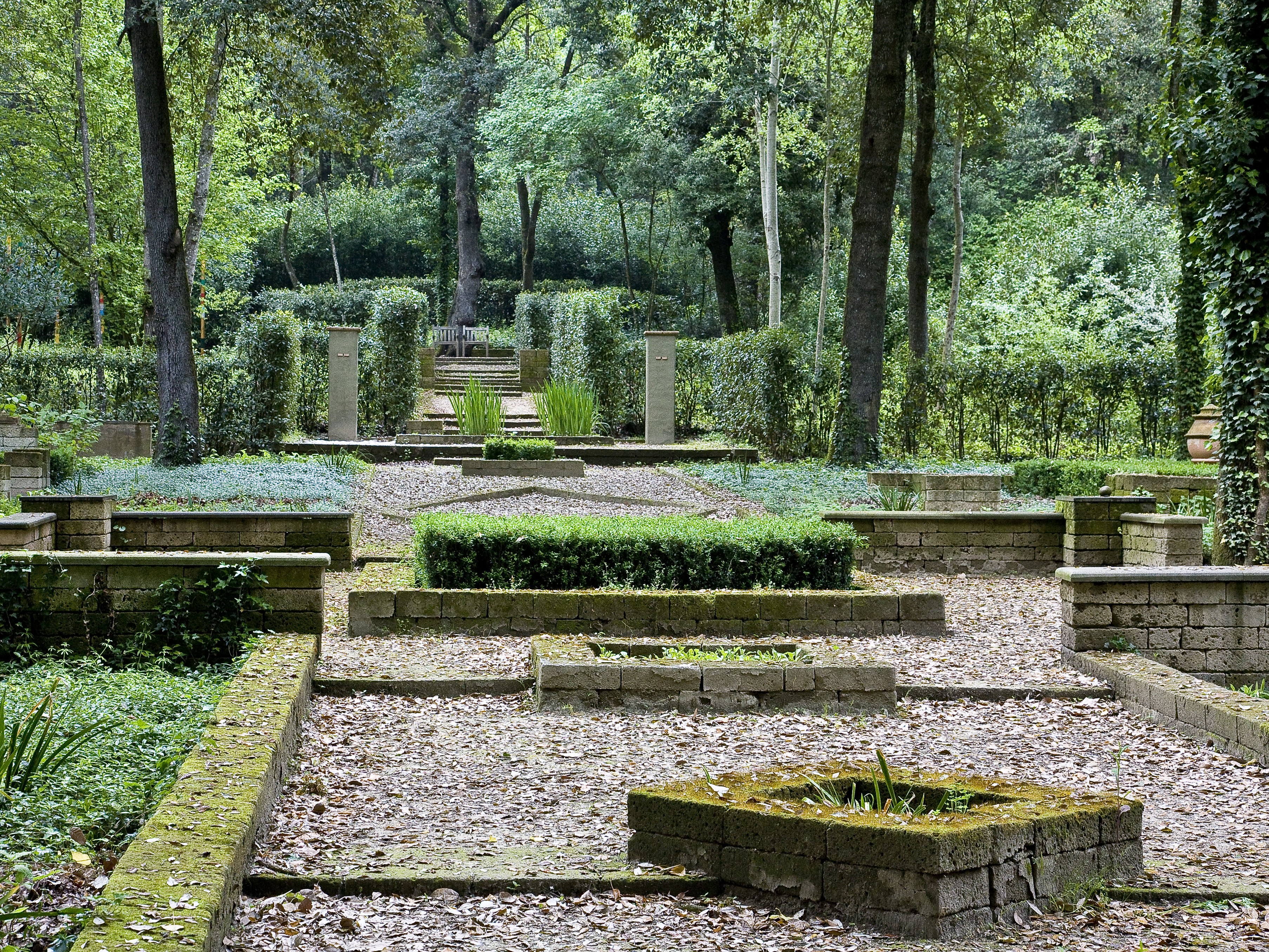
Just outside the village of San Giovanni d’Asso, a small medieval town nestled in the Crete Senesi landscape in Tuscany, lies an oasis of greenery and culture: the Bosco della Ragnaia. Once a place where birds were hunted using nets, today it is a most unusual sculpture park.
At the entrance, a motto greets visitors: "If not here, where?" In this forest—once ruled by the Sages and inhabited by Creatures—you are free to open your mind and interpret life however you wish. Only one interpretation is forbidden: believing yours is the “right” one. That, according to the forest's spirit, would earn you the title of fetid and vacuous. Ambiguity and open meaning are the guiding themes of this journey through the Magic Forest.
The garden is the creation of Sheppard Craige, an American landscape painter who sculpted fountains and conceptual installations into a grove of evergreen oaks, transforming the arid Crete Senesi terrain. By blending the natural surroundings with elements of the Renaissance garden, he crafted a philosophical path through the great questions of human existence—always approached with a healthy dose of skeptical, irreverent humor.
The experience begins with a Triumphal Entrance. Traditionally reserved for emperors and popes, here the triumph is for everyone. It invites each visitor to celebrate a personal victory—whether large, small, or seemingly insignificant. This is your triumph, and it's worth honoring.
Next, you step into the forest. It’s a grove of holm oaks—a mythical tree that once offered shelter to nymphs and satyrs, gorgons and harpies. These creatures symbolically accompany you through an increasingly emotional and reflective journey.
You soon reach the Hill of Painted Poles, and at the top, a series of inscriptions contemplate the theme of time. No one really knows what time is—if it’s anything at all. Scientists say it began with the Big Bang; the Sages of the forest say it never began. Continue on, and you arrive at the Oval Circle, with a holm oak at its center. As you walk through it, the circle subtly shifts shape—becoming an oval, a small metamorphosis in real time.
Just beyond stands the Throne of the Forest, once occupied by the Sages and flanked by the forest’s protector gods: Pan, the wild Greek deity with goat legs, and Vertumnus, the Etruscan god of seasonal change.
Descending a short staircase, you come to the Monument to the Present Moment. The present borrows a bit from the past and a bit from the future, yet belongs to neither. The monument highlights the significance of being here, now. Inscribed on it is the word “everywhere”—perhaps implying every moment is the same everywhere. Or perhaps not.
From a panoramic viewpoint offering a full view of the park, a staircase leads past the Fountain of Common Sense. Water—long seen as a symbol of wisdom, healing, and life in myths and religions—is here simply the source of common sense. And that, it turns out, is a major step forward.
At the base of the staircase is the Round Pond, with a stone in the center inscribed “aequus animus,” or “equanimity.” The stone floats at water level—neither above nor below.
Just beyond is the Altar of Skepticism, honoring the great French skeptic Michel de Montaigne, known for asking, “Who am I?” The altar stands on a bed of violets—the flower of discretion.
Through a nearby gate lies the Long Road to the Deep North, designed to be a forced-perspective illusion: it appears much longer and narrower than it is, thanks to strategically placed pots—many now missing, which diminishes the original effect.
The path leads to the Center of the Universe, a sand circle framed by four columns, each bearing an inscription visible only from the center. Some may laugh at the idea that this is the universe’s true center, but again—if not here, where?
Next, follow the Narrow Path, lined by five white posts that seem to promise something… but nothing happens. Eventually, you reach the Oracle of Yourself. There’s no priestess here—just a stone slab. This is where you ask your own questions and find your own answers. The proper method: close your eyes, trace a circle on the stone with your finger, sit on the bench, and wait for the response within.
On the way back, just before the gate, a trail climbs to a tall column near a hedge that marks the Italian-style garden. This is The Place That Could Be Different. You can imagine it however you like—but it is, in truth, exactly as you see it. The column commemorates this paradox.
Follow the Italian garden path to the Travertine Bench, which bears an inscription: “What we observe is not nature itself, but nature exposed to our method of questioning.”
Directly ahead is the Great Gong, which visitors are free to strike—just swing the two colored tubes against one another. The sound it produces is said to be therapeutic.
Now descend into the Garden of Day and Night: two narrow fountains flank the oldest and largest tree in the forest. Stones nearby are engraved with “Day” and “Night”—but it’s at twilight that the garden reveals its perfect harmony.
Enter the laurel-lined avenue and pass through the Pillars of Rhetoric. One is Affirmation, declaring, “This is how things are.” The other is Ambiguity, replying, “Maybe not.” From here, a trail leads out of the forest. Across from the Pointing Finger, you’ll find the Narrow and Straight Path that leads to the Secret Garden.
Looking back, you can see the forest’s central axis extending to the Shelter. On the year’s shortest day—the winter solstice—a ray of light aligns perfectly along this path.
If not here, where?



